If you want to go hiking in Maine, you’ll probably end up being bombarded by options in Acadia National Park. It is the most popular hiking area in the state. However, if you are looking to get away from the crowds, but have an incredible hiking experience in Maine, then you’ll want to go west away from the coast and into the Maine high peaks region where you’ll find 10 4,000-foot peaks.
There you will also find the Maine Huts and Trails Organization. It is a nonprofit organization whose mission is to “create and operate a world-class system of back-country trails and eco-lodges for people-powered recreation to enhance the economy, communities, and environment of Maine’s Western Mountain region, for the benefit of current and future generations.”
It’s a wonderful organization that serves up some of the best hut-to-hut trails in the US. I was lucky enough to go hike their system to see the fall colors in Maine in late September. The trail and hut system won me over and was one of the best hiking experiences I’ve had in the US! There are other hut experiences out there, like in my home state of Colorado, however none really to the caliber and service of the Maine hut-to-hut system. And the best part is that it is in its infancy. With the first hut being built in 2008, it’s not all that well known outside of Maine! So here’s a little hidden US hiking gem – just for you!
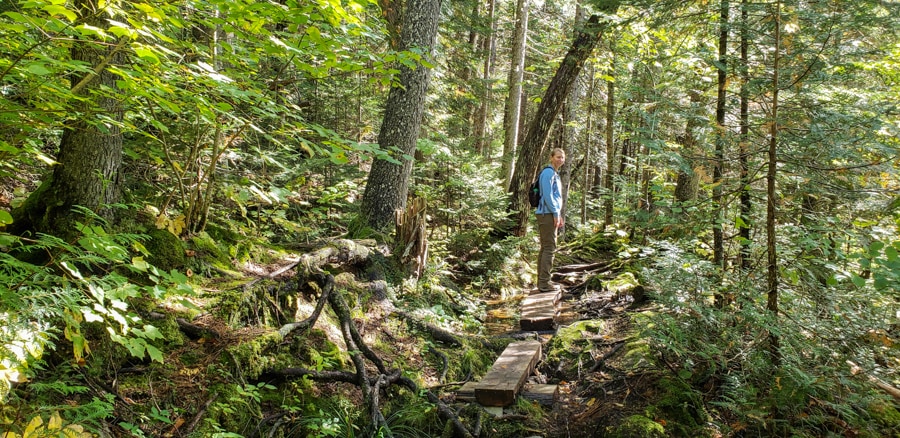
Table of Contents
Maine Huts and Trails History – It Takes Someone With Vision
In the 70’s, local Larry Warren had a vision: a series of back-country huts that would allow multi-day Nordic ski trips from Moosehead Lake to the Mahoosuc Mountain Range. He was inspired by the hut-to-hut treks throughout the European Alps he had experienced and wanted to bring them to Maine.
The ultimate vision was to have 8 huts/lodges all connected by trails; currently, there are 4 with the plan to build more. The system is connected by 80 miles of trails. It has evolved from the original idea of Nordic skiing to a complete year-round hiking, mountain biking, snowshoeing, and skiing wonderland. The best part is that the organization has brought a bounty of benefits to the local community; education, protecting natural habitats, supporting local farmers and brewers, as well as ensuring low-impact access to nature for generations to come.
Sort of like the National Parks, this community has come together to make their own protected land. I hope we see more of this all over the US!

This is a great area to plan a family outdoor vacation, a friend getaway, or do a solo adventure like I did. Here’s everything you need to know about Maine Huts and Trails if you are thinking about going beyond the Maine coastal road trips and want to enjoy the interior.
What Can You Do at Maine Huts and Trails
Even though you can slice and dice a Maine huts and Trails trip many different ways, I’m mainly focusing on the aspect of going hut-to-hut since that’s what I did this fall.
The hut system was originally built with winter skiing in mind however in the winter you can also fat bike and snowshoe from hut to hut. The distances between huts are pretty long for snowshoe hikes (some are around 11 ½ miles) but certainly do-able.
In addition, if you want to traverse hut to hut in the summer you can also do this on mountain bikes (there are separate trails for this) or you can hike like I did.
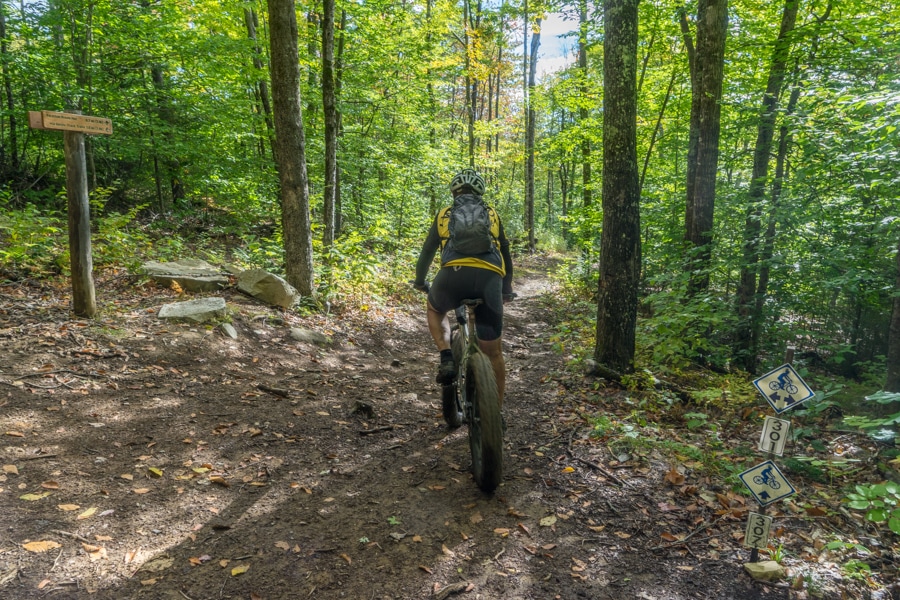
Distances Between Huts
Trailhead to Stratton Brook Hut – 3 miles
Stratton Brook Hut to Poplar Hut – 8 miles
Poplar Hut to Flagstaff Hut – 11.5 miles
Flagstaff Hut to Grand Falls Hut – 11.6 miles
Grand Falls Hut to the Trailhead – 14 miles
If you don’t feel like going from hut to hut, you can also stay multiple nights in one hut and do activities from there. All of the huts offer extra trails, hiking, and bird watching. Flagstaff Hut also offers swimming, and canoeing/kayaking on the lake while Grand Falls offers fly-fishing. You are also able to kayak or canoe between Flagstaff and Grand Falls if you wish. This was one of my favorite parts of my experience; taking off the hiking boots, canoeing for 6 miles, and giving my legs a break was a great new perspective.

Trails, Markings, and Maine Huts Map
The trails are well-marked with the Maine Huts and Trails signs. Even when I hiked on my own I had no problem finding my way. The trails were maintained wonderfully; I was impressed with the whole system.
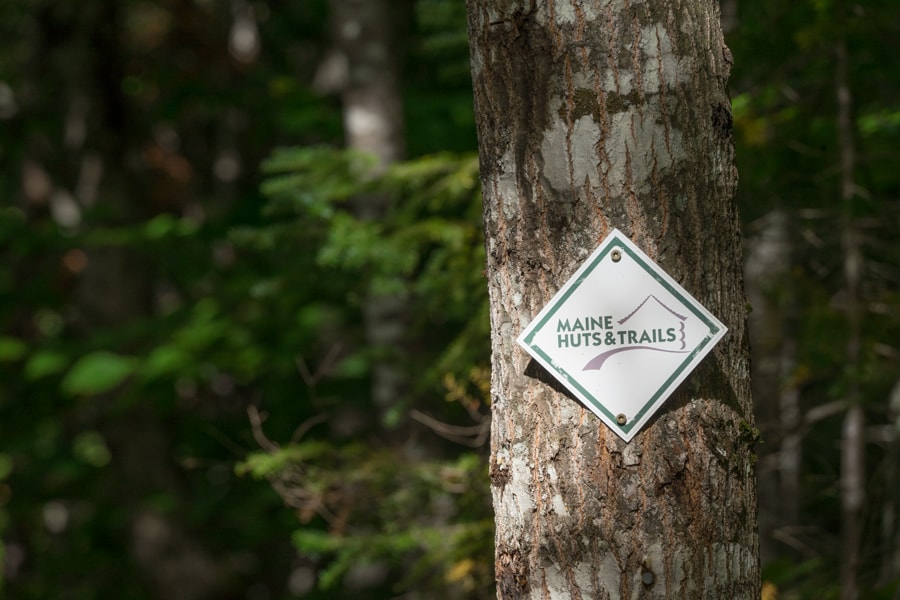
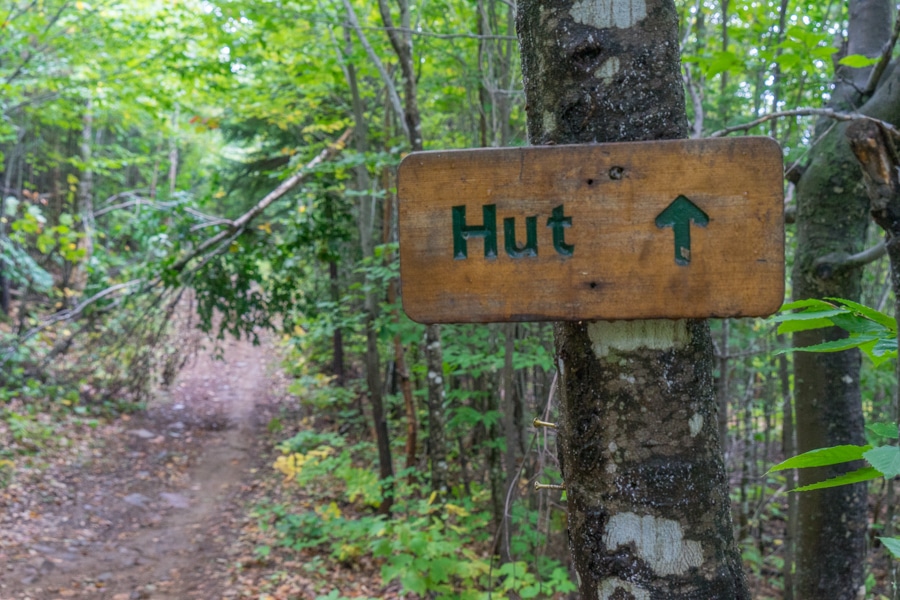



For a detailed description of each of the trails and its difficulty – check out the Huts and Trails website here.
Download a PDF of the entire trail
Why Is It Called a Hut – It Doesn’t Look Like a Hut!
The whole time I was hiking hut to hut, I kept thinking…these aren’t huts – they are so much more! The visionary of Maine Huts, Larry Warren, told me they chose to call these beautiful lodges huts because “The term ‘huts’ has become synonymous with AMC, 10th Mountains, New Zealand, and European networks, and we adopted the term as it more clearly defined the experience as opposed to the hospitality facility.”
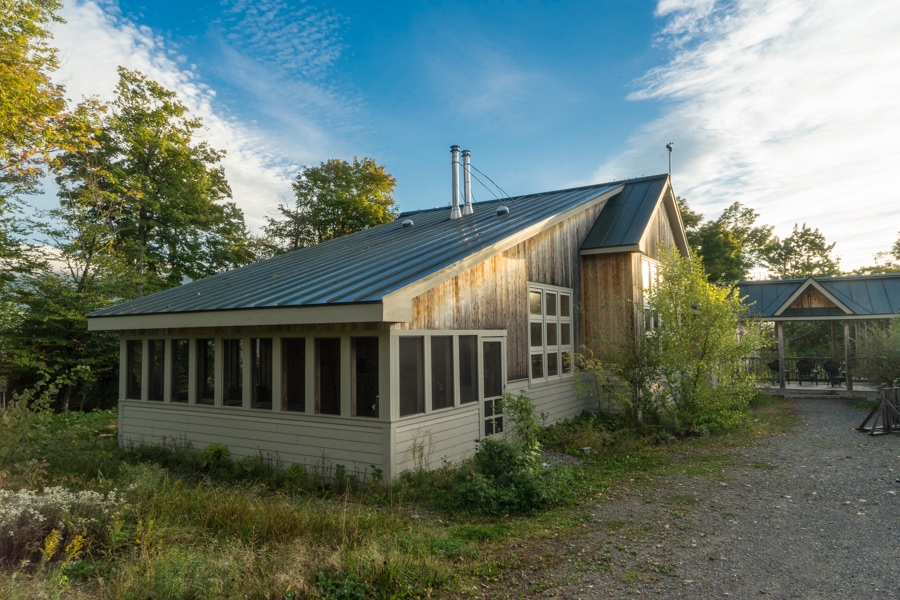



I don’t care what you call them, they were simply amazing works of architecture and responsible tourism. Each hut was off the grid; run by solar power, composting toilets, and heated by 13 chords of wood each winter. But more than that, they were an oasis of hospitality in the middle of the remote Maine Woods!
Review my hiking packing list – essential hiking gear for any hike
Each lodge has a spacious great room with long tables for communal dining. You’ll also find a reading area with fireplaces/stoves and comfortable couches and chairs. Every lodge also has a screened-in porch to keep the pesky bugs away. The main lodge building also houses the bathrooms/showers and kitchen for the staff. The bunk/sleeping areas are always separate from the lodge. The bunkrooms have various configurations, but normally each room sleeps from 3 to 6 people in simple bunk beds. A pillow and mattress are supplied, but you must bring your own sleeping bag or quilt and a pillowcase. Note that the bunkrooms are heated, but they are not HOT. A sleeping bag is definitely necessary.






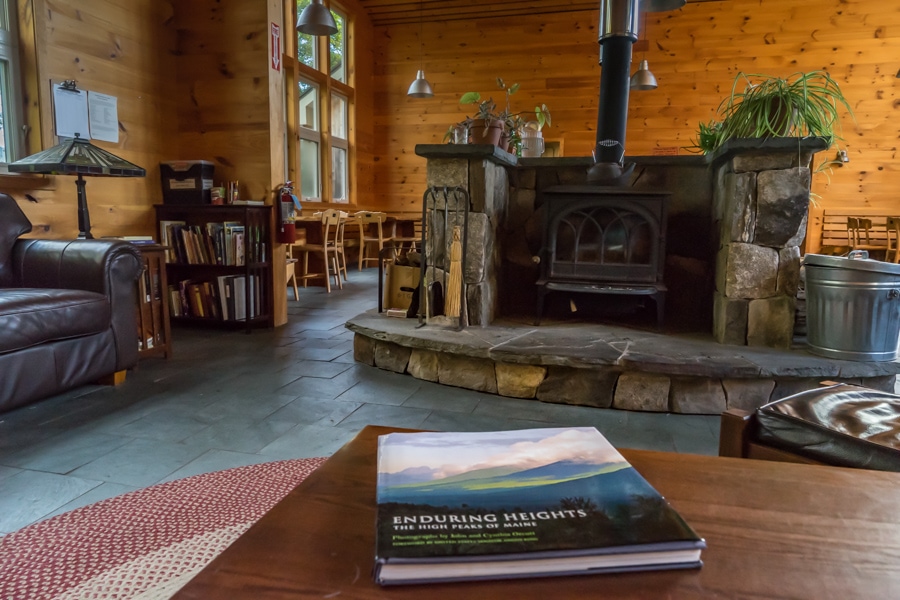



Hut to Hut Eco Lodging and Sustainability
The huts are a great way to see the latest in sustainable building. In fact, every hut offers a little eco-tour of the inner workings of the system each night normally after dinner.
Each hut is powered by solar and batteries, plus Poplar Hut also uses Hydropower from the nearby waterfall/stream. Wood is used for heating and a wood gasification boiler supplies the hot water. The showers are on timers so that water doesn’t go to waste.
However, the most impressive part of the eco-lodges is likely the compost toilet and system! All of the human waste is broken down into fertilizer while releasing a minimal amount of CO2 into the air. Each hut produces about two wheelbarrows worth of garden-ready fertilizer every four years!
While I was there in the fall for the beautiful fall colors, it was also wood-cutting season. The Hut workers were busy chopping wood and stacking for the winter. They use over 13 cords of wood per year. And if you want to help out, they will gladly accept more hands to help with stacking and chopping!






Back Country Food and Drink
One of the main things that sets Maine Huts & Trails apart from any other hut-to-hut hiking I’ve done or even know about is the incredible food they include in your stay! We ate homemade oatmeal buns, stir-fried beef, squash, green beans, pasta, fajitas, apple pie, and blueberry crumble – not to mention the great breakfasts and packed lunches we also received! Maine Huts and Trails team up with nearby farms and procure sustainably raised meat, fresh produce, and grains to keep the huts stocked with high-quality ingredients. They even have their own specially brewed craft beer called MHT (Maine Huts & Trails). The talented hut crew prepares three feasts per day as part of your stay; you won’t leave hungry.
Beer and wine are not included and need to be purchased with cash at the lodges. Please note that cell phones are not allowed to be plugged in and charged anywhere in the huts. In fact, they are really discouraged at all.


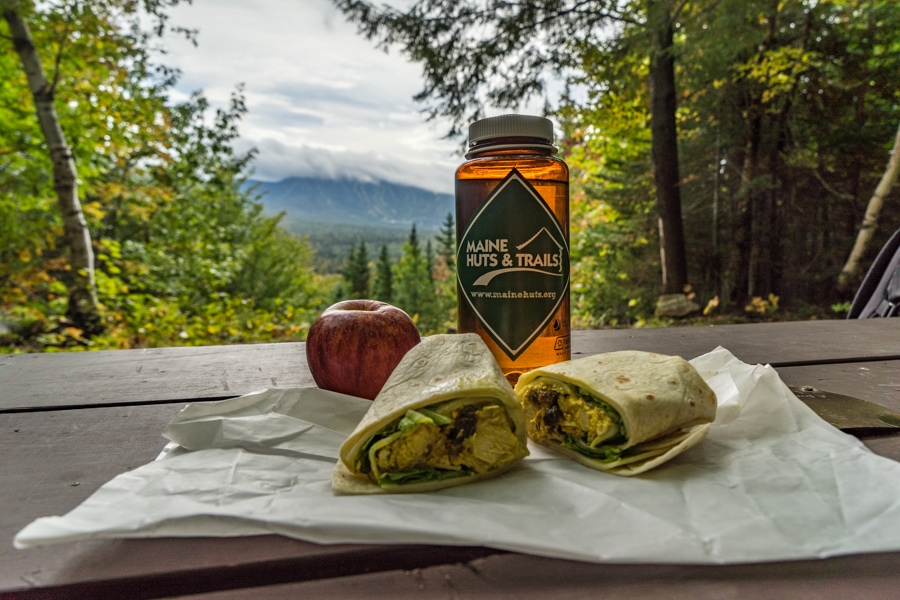






The huts are fully serviced for most of the year – however there are a few months where they are self-service, but they are always open. You can see the schedule here.
What Should You Bring On A Hut to Hut Trip
Backpack
I used the Deuter Futura 45+10 which was designed for multi-day hut-type hiking in mind! I tested this out on my Maine Hut to Hut trip as it’s 55L can carry a sleeping bag/quilt and has space for multi-day hikes. This is the perfect size for multi-day hikes where you aren’t carrying a tent (think Camino de Santiago, St Olav Ways, Hut to Hut hiking, etc).
This particular pack is part of Deuter’s women’s series because women are built differently than men…duh. It has a Vari-Slide System allowing exact adjustment to every back length; ensuring the pack sits perfectly on your hips. Plus the waist belt also moves with you as you step ensuring comfort for long-term wear. I carried about 33 pounds in it for my Hut to Hut hiking in September and it worked great. I had no back or shoulder pain and the back ventilation system kept me cool. I’m a believer in packs designed for women!
Sleeping Bag or Quilt
You can certainly take a sleeping bag with you, but I chose to try out a sleeping quilt instead for this type of trip. The Thermarest Quilt is a hoodless, backless, zipperless sleeping bag with a fully enclosed foot box opening at knee level. It’s more like a sleeping blanket made of sleeping bag material that can hook to your sleeping pad or can simply be used like a blanket. It’s meant for summer camping and hut-to-hut-type treks where you have a bed but have to bring a sleeping bag. Down quilts are cheaper, lighter, and have a higher warmth-to-weight ratio than traditional sleeping bags. As such, they’ve become a staple in ultralight and lightweight backpacking kits. I loved how light and small it was in my pack but it kept me toasty warm in the unheated huts.
And don’t forget a pillowcase for the bunkroom too!
Hiking Boots
The trails aren’t super technical, so a nice lightweight boot is perfect for this kind of hiking. I used the OBOZ Bridger which has good tread and support but isn’t bulky. They are also waterproof which is essential to have as you may get caught in a stream or a downpour.
Comfortable Shoes
After hiking all day the first thing you’ll want to do is take off those hiking boots and socks! Don’t forget to bring another pair of comfortable shoes to lounge around the lodge. I brought my Chaco’s, which I love for comfort and ease after hiking. It’s like putting on a slipper! I would simply hang them off the back of my backpack just in case I felt like switching out of my hiking boots during the day. They were perfect for when we did canoeing too!
Hat
Don’t forget a sunhat. Even though you are in the woods a hat is always great protection!
Hiking Poles
This year I have been using Montem Carbon Fiber hiking poles. I love the flick locks that allow you to quickly adjust them to any height and they stay super secure. I also love the cork grips, which absorb sweat for summer hiking. However, I think my big selling point is that they are affordable carbon fiber poles – most poles in this category cost much more.
Photography Gear
This Cotton Carrier camera harness is great for holding your camera securely (no swinging or jiggling!) while you hike, row, bike, or snowshoe. It was perfect for this fall trip so that I could take lots of pictures of the fall colors! It’s easy to quickly pull out of the chest lock and use the camera in one smooth motion. But the best part is that the harness is dispersing the weight properly instead of around your neck only. This is a must for any outdoor photographer!
See the rest of my recommended travel photography gear.
Hiking Pants and Layers
The time of year will dictate your clothing needs. However, even in the summer, it can get chilly at night so always bring a few layers even in the summer.
Rain Gear
What is a Cagoule you ask? It’s a lightweight, hooded, thigh-length waterproof jacket from Sierra Designs – perfect for hiking in the wind and in the summer months when you are hiking with shorts. This pullover jacket is big enough to likely cover your pack and your shorts. It’s like a sturdy poncho in a way and I like those for summer hiking and storms. Plus – it folds up in itself when you aren’t using it!
Every hiker needs a good pair of tear-away rain pants. They will keep you dry on the trail and get you in touch with your inner stripper! I used these Sierra Designs ones and they worked great. These don’t exactly ‘tear away’, but they do zip all the way up the leg so you can easily and quickly put them on over your boots in a downpour!
Other Hiking and Backcountry Necessities
Don’t forget a headlamp, and hike with a first aid kit and whistle.
My Complete List of Recommended Hiking Gear
See my favorite gear for trail hiking at my Amazon Travel Store
Hiring Hiking Guides
If you want a guide you can hire one through Maine Huts and Trails. I had a guide for one day and loved it. She was a wealth of knowledge teaching me all about the flora and fauna of the region. It was just nice to sit back and let someone else lead for a while! You can hire guides for hiking, snowshoeing, skiing, canoeing, kayaking, and fishing. Some of them even run regular group trips at the huts around themes like yoga, kayaking, full moons, or women-only!
Luggage Transfer Between Huts
One of the things that make this hut-to-hut system so great is that they offer luggage transfers! They offer this service for an extra fee of course, but it’s worth it if you don’t want to carry 30 lbs like me! They offer the service in summer and winter (by snowmobile). There are some key restrictions though, they only move backpacks (no suitcases, totes, or duffles), and they must be under 25 lbs. There are specific pick up and drop off places where there are tags, pens, and scales available. However – you can’t decide this last minute, it must be booked a week ahead of time.
See all of the rules and schedules of the gear shuttle here.
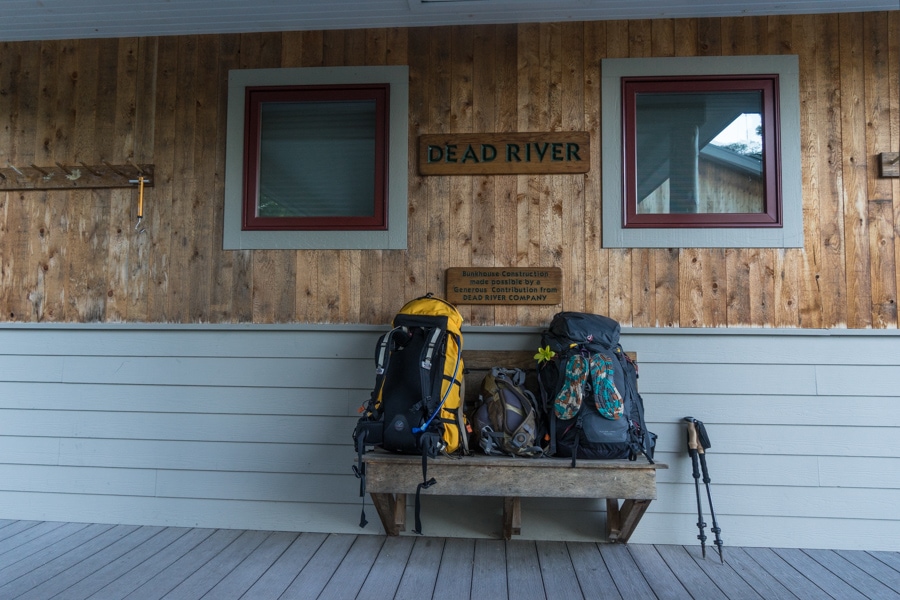


But What About Our Car?
I know what you are thinking, if you do a hut-to-hut trip and leave your car at the beginning of the route, how do you get back to it when you end? They have thought of that too…that’s just another thing that I love about this system! Greg at All Point Transportation will be more than happy to help you move your car! Seriously, he moves cars from the beginning parking lot to the end to be there for you when you are done.
Or better yet – why even bother with a car? Greg actually came and picked me up at the Portland airport and drove me to the trailhead. Then he’ll pick you up at the end and can drive you back. It’s going to be about the same price as renting a car and paying for it to sit there!
Plus – Greg is a great guy – I had a super time talking to him. Contact him at All Points Transportation and let him know what you need, I’m sure he can help you!
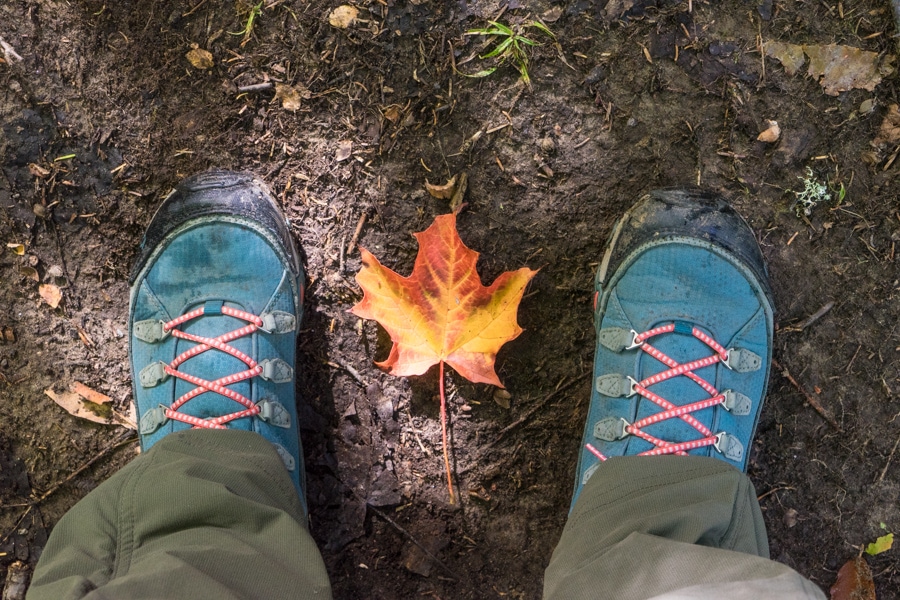
OK, How Do I Book It?
This is the easiest part, simply call the Maine Huts and Trails Reservation Department and they will answer any of your questions and be able to set up a great itinerary for you!
Maine Huts and Trails Reservations (207) 265-2400.
Plus – you can find much more information on their website here.
This was by far one of my favorite hiking trips I’ve done. I hope you check them out and see these beautiful huts for yourself! I can’t wait to go back!
Related Posts:
Essential Hiking Gear: An Easy-To-Use Guide for Any Hike
Training for Hiking Long Distances
Best Hikes in the World I’ve Personally Completed
7+ Thru-Hiking Trails Around the World: Alternatives to the Camino de Santiago
Disclosure:
I was a guest of Visit Maine for this hiking trip, however all opinions expressed here are my own.
Disclosure:
This post contains some affiliate links. If you choose to purchase items through these links, I will earn a small commission at no extra cost to you. These commissions help reduce the costs of running this site








By Oman Tours February 9, 2019 - 1:11 am
I went through your article and it’s totally awesome. I am searching for a blog about the food, and my search ends with your blog. Keep on updating your blog with such awesome information.
Thanks